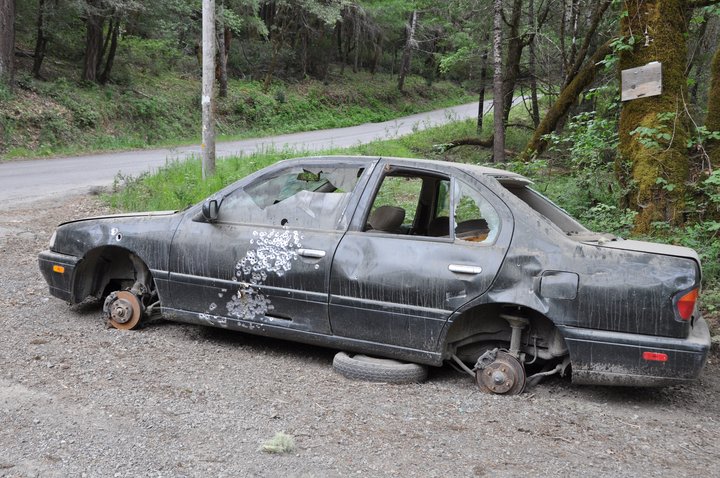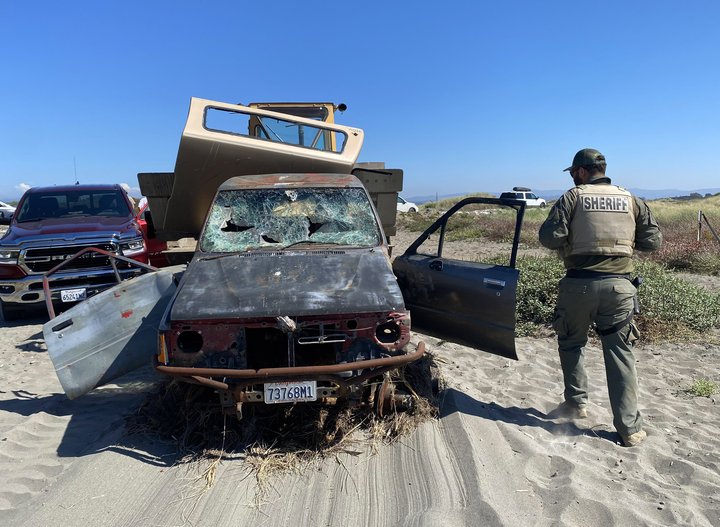A bullet-riddled abandoned car in rural Humboldt County. Photo: HCSO
###
We are all aware of the issue of abandoned vehicles in Humboldt County. You’re on your way to work or to drop the kids off at school and there it is: a once-loved Dodge Neon carelessly dumped on the side of the road. Ah, yes, you begrudgingly whisper. The cycle begins.
The severity of the dumped car lifecycle generally depends on where you’re located in the county. If you’re in town, the damage tends to be relatively minimal, but if you’re on the Samoa Peninsula or out in the hills, that aging sedan will be ravaged by hellions in a week’s time.
The windows usually go first. Then the tires and catalytic converter are stolen. The car is bashed up a bit, gutted, and usually spraypainted or tagged in some way. Destruction often culminates in the car being used for target practice and/or being set on fire. And there it will sit, sometimes for months.
The county has tried to address this issue for decades. Most recently — in 2012 — voters passed Measure Y, the Humboldt County Abandoned Vehicle Abatement (AVA) Program ballot initiative, to renew the county’s existing efforts to deal with the problem. The measure asked voters to approve a vehicle registration fee of $1 per vehicle and $2 for certain commercial vehicles to fund a program to reduce community blight by removing and disposing of abandoned, wrecked and dismantled vehicles.
Measure K, an initiative to re-renew the AVA program for another 10 years, will be up for voters’ consideration in June. If passed, the ballot initiative would continue to generate approximately $160,000 annually for vehicle abatement purposes.
The Humboldt County Sheriff’s Office (HCSO) functions as the administrator of the county’s AVA fund and oversees a budget to cover vehicle abatement after state funding had been exhausted.
“We have in the past been granted supplemental money from the [county’s] general fund to help cover the costs of vehicle abatement, as it has been identified as a big, costly issue here in Humboldt,” HCSO spokesperson Samantha Karges wrote in an email to the Outpost. “…What people don’t realize is when they abandon their vehicles, the Sheriff’s Office is the one that has to pay to get rid of it. We have to pay the tow company for towing the vehicle, Eel River Salvage for disposing of the vehicle, and the personnel time. This adds up quickly.”
Disposal can range anywhere from $125 to $600, depending on the size and condition of the vehicle. Motor homes are “extremely expensive,” she said, and often cost between $1,500 and $4,000 to dispose of because they are often filled with garbage and hazardous materials.
The Sheriff’s Office spent $118,057.35 on AVA in Fiscal Year (FY) 20-21 and $164,108.57 in FY 19-20. A total of 1,862 vehicles were abated by the Sheriff’s Office between 2019 and 2021.
Those statistics do not apply to cities with their own AVA programs. For example, the Eureka Police Department (EPD) towed 439 abandoned vehicles within the City’s limits in 2021 through its volunteer AVA team, according to EPD spokesperson Brittany Powell.
“Abandoned autos can quickly become a nuisance and target for criminal activity,” Powell wrote in an email to the Outpost. “If a vehicle is abandoned and not quickly taken care of, parts slowly start to get removed, catalytic converter taken off, graffiti and trash.”
One of law enforcement’s biggest concerns with abandoned vehicles is people setting them on fire. “These vehicles have the potential to spark major wildfires,” Karges added.
The AVA process is generally complaint-driven and focused on vehicles that have been “truly abandoned and [are] causing a nuisance.” This does not apply to vehicles that are on private property or to vehicles that are being lived in.
When a vehicle is reported, it is marked with a bright yellow abatement notice and a letter is sent to the last known registered owner of the vehicle to inform them that the vehicle will be towed and crushed if it is not picked up within 10 days, or 15 days for out-of-state owners.
“Once the waiting period is over, we go out there and confirm that the vehicle is still where it was when marked,” Karges said. “If it’s still there, we fill out a tow request with a local towing company. Depending on how busy the towing company is, it could take up to a week to tow the vehicle. …Towed vehicles are transported to Eel River Transport and Salvage where they are crushed and disposed of.”
However, costs for disposal continue to rise. If the AVA program is not renewed through Measure K, most local agencies will not have adequate funds to keep up abatement services.
“Our Board [of Supervisors] and local cities all agree that the program is beneficial and should be put before voters for renewal,” deputy County Administrative Office Sean Quincey wrote in an email to the Outpost. “The program provides funding to help offset some of the costs related to removing abandoned vehicles from public areas. Most local agencies do not have alternate funding for such a program and without it they would need to either stop offering these services or locate other funding.”
More information on Measure K can be found here.
###
Deputies remove an abandoned vehicle from Samoa Beach. Photo: HCSO



CLICK TO MANAGE